SWITZERLAND
MONUMENTS
|
ALL ABOUT SWITZERLAND |
|
PICTURES MONUMENTS |
|||||
Important Swiss MonumentsPhotographsA little walk through
Switzerland's history |
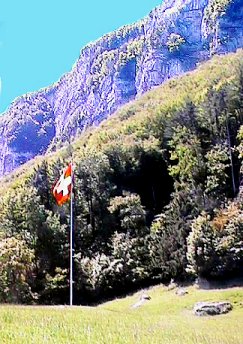 |
Rütli, Central Switzerland The so-called cradle of the Swiss Confederation is but a flagpost on a meadow at the feet of steep rocks on the shores of Lake Lucerne - but exactly this symbolizes Switzerland perfectly - at least for the traditionalists. Urban Swiss people do have slightly different views ... According to the legend, delegates from Uri, Schwyz and Unterwalden met on this meadow between Lake Lucerne and steep rocks towards the end of the 13th century and made an oath to help each other against oppression by the counts of Habsburg. |
||||||
| William Tell
Monument, Altdorf The legend says that William Tell refused to honour bailiff Gessler's hat presented on a rod, was forced to shoot an apple from his son's head with his crossbow, escaped from a boat carrying him to prison during stormy weather and finally shot the bailiff. Though it is most probable that William Tell never lived and that he is a purely ficticious personification of how the old Swiss confederates saw themselves, he is still very popular as a symbol of rebellion against arbitrary rule. The classical German writer Friedrich von Schiller made him immortal with his drama Wilhelm Tell.
The monument at Altdorf, capital of canton Uri, where
Tell is said to have performed his apple-shooting, was created in 1895
by Richard Kissling. |
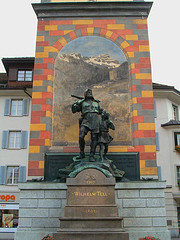 |
||||||
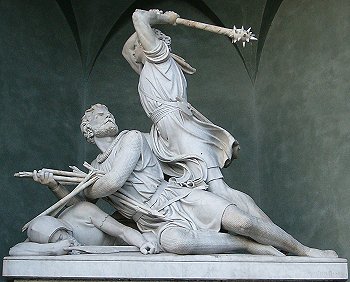 |
Winkelried Monument, Stans Arnold Winkelried, hero of the battle of Sempach (1386) is said to have directed as many hostile spears as he could grasp towards himself, so they were absorbed and the other Swiss fighters could attack the enemies deprived of their spears. |
||||||
| Habsburg Ancestral seat of the Counts of Habsburg near Brugg, northern Switzerland. The counts of Habsburg were the traditional enemies of the old Swiss confederation. Quite unsuccessful in trying to enlarge their influence over the stubborn population of central Switzerland, the counts of Habsburg left their castle in Switzerland and became dukes in Austria. Their new home Austria was the base for their dynasty as German and Austrian kings and emperors (in Austria until 1918). |
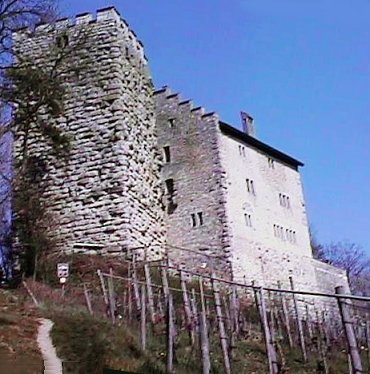 |
||||||
 |
Chillon Castle, Lake Geneva Founded by the dukes of Savoy, later seat of the bailiffs that ruled over northern shore of Lake Geneva in the name of the city of Bern. |
||||||
| Rüderswil: peasant's war memorial Reminds of an insurrection by peasants of the Emmental and Entlebuch region between Bern and Lucerne back in 1653. Rüderswil is the home of the peasants' leader, Niklaus Leuenberger (relief of his head on the memorial and Leuenberger family flag on flagpost). |
 |
||||||

|
Jean-Jacques Rousseau Geneva, Ile Rousseau Famous Geneva born political philosopher and writer In his main work Du contrat social Rousseau talks of a volonté général [general will]. His idea was explicitly rooted in his experience with elementary forms of direct democracy on local level, but could be - and has been - misunderstood and abused by totalitarian French revolutionaries and later by communist thinkers. |
||||||
| Lion Monument,
Lucerne The Lion Monument in Lucerne reminds of the mercenary soldiers from central Switzerland serving the French king Louis XVI that were killed during the French Revolution at the Tuileries in Paris in 1792. Mercenaries' services were an important economic factor in central Switzerland before the industrialisation. |
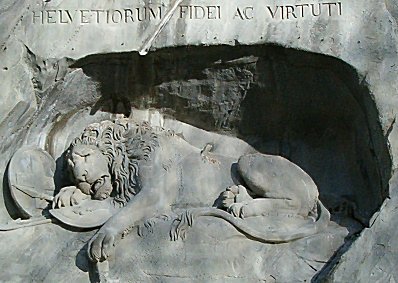 | ||||||
| The latin inscription HELVETIORUM FIDEI AC VIRTUTI means "To the loyalty and bravery of the Swiss". The erection of this monument was proposed by conservative captain Carl Pfyffer von Altishofen, the design is by Bertel Thorvaldsen from Denmark and it was crafted by stone-mason Lucas Ahorn from Constance (southern Germany) in 1820/21. Lucerne erected this monument in spite of massive protests by liberals from other parts of Switzerland. Learn more about the Lion Monument | |||||||
 |
Johann Heinrich Pestalozzi monuments in Yverdon-Les-Bains and other towns Pestalozzi was a famous Swiss pedagogue in the late 18th / early 19th century. He founded several educational institutions both in German and French speaking regions of Switzerland and wrote novels explaining his revolutionary modern principles of education. His motto "Learning by head, hand and heart" is still a key principle in successful 21st century schools. Thanks to Pestalozzi, illiteracy still prevailing in 18th century Switzerland was overcome almost completely by 1830. |
||||||
| General Guillaume Henri Dufour Geneva General Dufour was commander in chief of the victorious federal troops in the 1847 civil war against an illegal alliance (Sonderbund) of conservative politicians trying to stop the evolution of democracy in Switzerland by armed force. Dufour is also remembered as an advocate for the introduction of the Swiss flag in the Swiss army instead of traditional cantonal flags (1840) and as co-founder of the International Committee of the Red Cross. |
 |
||||||
 |
Monument National Geneva |
||||||
|
Strassburg Monument Basel This monument expresses the gratitude of the French city of Strassburg for Basel hosting women, children and aged persons when Strassburg was besieged during the German-French war of 1870/71. |
 |
||||||
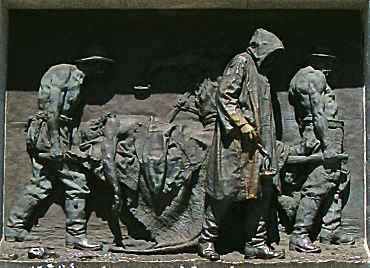 |
Gotthard Monument,
Airolo (Airolo railway station, south portal of St. Gotthard tunnel)
The inscription |
||||||
|
Wehrbereitschaft [ready for defense] Schwyz This monument symbolizes what Switzerland called its Spiritual Defense against Nazi Germany at the eve of and during World War II. |
 |
||||||

Short quotations allowed but with precise declaration of origin (Link).
Reproduction of substantial parts and pictures in printed or electronic form
only with explicit written consent by the editor.
| Disclaimer | Privacy Policy | www.all-about-switzerland.info © 2005-2010 All Rights Reserved | Editor | ||